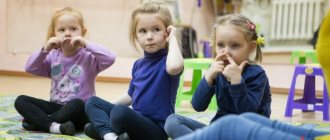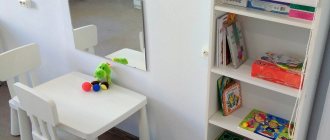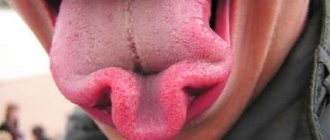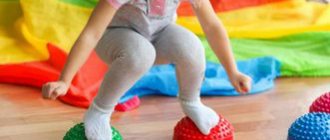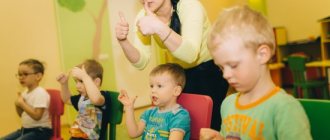One of the important features of a child in the future is the development of thinking today. It is important to start paying attention to this as early as possible.
There is such a thing as a “sensitive period”. This is the optimal stage for developing a particular skill. For children, the period when the foundation is laid is from 1 year to 7 years.
In the article we will talk about the stages of development of thinking in children, methods, and the connection of thinking with other skills.
Features of thinking in preschool age
The brain of a preschooler is mobile and malleable, open to new knowledge. That is why useful habits, the desire to engage in sports, music, theater and art are laid precisely in the preschool period.
In order for a child to analyze and think, it is necessary to constantly set new tasks for him, as well as modernize and complicate the skills he has already acquired.
There are several factors that have a strong influence on a child’s thinking:
- Circle of friends. The older the child, the more children and adults there should be around him. Kindergartens, clubs and sections help with this. The child must observe different behavior patterns of both adults and children.
- Speech development. The child learns to construct sentences and express his thoughts.
- Formation of an analytical worldview. Preschool children are characterized by paying attention to shapes, color, size, spatial arrangement and time frames.
- Acquiring skills and abilities. The child learns to retell, read syllables, and sing.
- Formation of personal qualities. Character, adaptability, initiative, organization - all this is formed as a result of educational activities.
- Formation of self-esteem. A developed child is able to evaluate himself.
- The emergence of self-control. The child learns to manage his behavior and actions.
Stages of development of thinking
- visually effective;
- visual-figurative;
- verbal-logical.
Visual and effective thinking is formed at the age of 1-3 years. When, as a result of his actions, a child, without realizing it, draws conclusions “for the future.” And proof of this are toys, keyboards, and parental gadgets disassembled for spare parts. The purpose of these actions is to know “what’s inside?”
At the age of 3-7 years, visual-figurative thinking is formed. It is during this period that the first signs of analysis appear. For example, having certain skills, a child can already tell what a toy will feel like when he sees it in a store window. Many can already predict the situation.
Closer to 6 years, the first inclinations of verbal and logical thinking appear. At this stage, the child begins to give detailed answers after analyzing information, is able to arrange the sequence of events in the correct order, and can characterize almost any object. Speech is of paramount importance on the development of a child’s thinking.
On the topic: methodological developments, presentations and notes
Gender differences in the thinking characteristics of preschool children
In connection with the changes taking place in the preschool education system, the most pressing issue has become the gender approach to the education of preschool children...
Features of the development of logical thinking of preschool children with the help of logical and mathematical games
It is most advisable to develop the logical thinking of an older preschooler in line with mathematical development.
The development of logical thinking through didactic logical-mathematical games is important... Features of the development of thinking in preschool children.
Are we brothers in mind? There is still an opinion in families that a child is a small, imperfect adult who knows less and understands life less well, that the differences between a child and an adult are purely quantitative...
Features of the thinking of preschool children
Features of the thinking of preschool children...
Seminar for teachers “Features of the development of logical thinking in preschool children”
Development of logical thinking, functions of logical games. Practical advice for teachers….
Report on creating conditions for the formation of imagination and imaginative thinking in preschool children through artistic and aesthetic activities.
Report on creating conditions for the development of imaginative thinking and imagination of preschool children.....
Features and stages of development of thinking of preschool children
Thinking is a cognitive process of a higher level compared to the direct sensory reflection of reality in sensations, perceptions, ideas. Sensory knowledge gives only...
- I like
Sources used:
- https://alldoshkol.ru/process/razvitie-myshleniya-u-doshkolnikov
- https://marypop.ru/doshkolnik/razvivayushhie-zanyatiya/razvitie-myshlenija.html
- https://nsportal.ru/detskii-sad/vospitatelnaya-rabota/2017/07/04/osobennosti-vidy-i-svoystva-myshleniya-detey
Mental operations
Observing how a child’s thinking develops, the entire thought process can be divided into stages:
- comparison;
- analysis;
- synthesis;
- generalization.
At the comparison stage, the child learns to find the same in different things, different in the same. During this period, it is appropriate to give “find the differences” pictures and play memory games (start with 6 pairs of pictures, gradually increasing the number).
At the analysis stage, features, qualities, properties, materials and objects used are identified. In his imagination, a child can divide any product into its component parts.
The synthesis stage is closely related to the analysis stage. Without analysis it will not be possible to synthesize. An example of this is reading. Without remembering letters, without understanding how they merge into syllables, a child will not be able to read.
Vivid signs of generalization are the identification of common characteristics of objects and grouping. As soon as a child develops coherent speech and the use of a large number of generalizing concepts, you know that the generalization stage has begun.
How to develop a preschooler's thinking
The development of thinking occurs through play, as this is the leading type of activity. You can beat everything. From a pedagogical point of view, it should be developed in different directions. Involve your child more in housework.
Check out the table; it contains the main types of exercises for developing thinking in children, which we focus on in our classes.
| Types of activities | Description |
| Memory development task | Memorizing image elements, sequence of details, etc. |
| Logic exercises | Find what is missing, identify a pattern using analysis, comparison, reasoning |
| Classification tasks | Sorting, grouping by characteristics, etc. |
| Exercises for concentration | Finding identical properties, differences between objects, images, etc. |
| Tasks for the development of spatial perception | Development of visualization, spatial arrangement, solving puzzles and puzzles |
| Exercise to develop analytical skills | Search for details that are superfluous or not true |
| Tasks for the formation of a strategic approach | Thinking through a whole chain of actions. Analysis of sequences and results |
How to develop logic in older preschool children
Psychologists, when asked how to develop the logic of a child of middle and senior preschool age, emphasize the intensity and activity of such work. By the beginning of school, children must master all logical operations: operate with a variety of concepts, reason independently and make inferences. Training should become permanent, so it is advisable to include games and exercises not only in special activities, but also in everyday life.
Important: in order to achieve a high level of development of children's logic, parents must make intellectual communication with their child a way of life.
This can be facilitated by both special tasks and games organized in family communication. The most popular of them are designed for solving logical problems: “Make a figure from matches”, “Sea battle”, “Tic-tac-toe”, puzzles, chess, puzzles. While walking in the forest, parents must draw their children’s attention to the diversity of the surrounding nature and teach them to see the general and the particular in the objects they observe. Nature provides great opportunities for a child to develop the ability to find and analyze cause-and-effect relationships: “If the clouds have thickened and darkened in the sky, it means ... (it will rain)”; “From the acorns lying under the oak tree... (young oak trees) will grow”; “Make a biological chain (flower-dragonfly-bird).”
"Let's play association"
Classic logical tasks for finding associations are intended mainly for older preschoolers. If work on child development is carried out over a long period of time, associations will be available to children of middle preschool age. The tasks broaden one's horizons, develop the ability to generalize, compare, analyze, and classify.
Tasks for middle preschoolers
An adult offers children pictures depicting objects of different groups: shoes, clothes, furniture, household appliances. The child must combine all the cards into different groups, based on common features. You can invite children to play with a ball, offering various interesting tasks:
- “say the opposite (soft-hard, big-small, laugh-cry, winter-summer)”;
- “name a similar object (ball-watermelon, sun-bun, snow-fluff, hedgehog-thorn)”;
- “Name in one word (apple, pear, plum – fruits, tomato, cucumber, pepper – vegetables, armchair, sofa, wardrobe – furniture).”
The classic ball game “I know three vegetables, fruits...” helps develop logic, the ability to think quickly, and enriches vocabulary.
Tasks for older preschoolers
To develop a child’s knowledge about associative connections, tasks for constructing logical chains are well suited:
- “complete the rows” - the child is offered a card with rows of similar objects, for example, toys: spinning top, cube, doll, bear; vegetables: tomato, cabbage, cucumber; clothes: jacket, sweater, trousers. The kid must select the appropriate cards, completing the row, and ask the older children to draw on the objects of the same group.
- “make a row” - the child is offered a card with drawn objects that are arranged accordingly, for example,
1st row – two dolls, two bears, two balls, 2nd row – doll, bear, ball, etc., 3rd row – two dolls, a ball, two bears, a ball. The preschooler must independently create similar rows using prepared cards or by drawing them. The task helps well in developing the child’s operations of generalization, analysis, and comparison. In the future, when preschool children master associative series, you can offer complex tasks:
- guess the row itself,
- guess the missing items,
- what is wrong in the series.
Logic toys for family leisure
Educational toys that are fun for the whole family to play with will greatly help in the development of logical thinking in preschoolers. The child’s development will take place in an immediate environment, which will help parents both play and teach their child with passion. Now you can find many logic games and educational toys on children's portals and specialized stores. Kids can be interested in logical inserts that will tell them about geometric shapes and teach them how to manipulate them; magic bags - will help to form concepts; mosaics - will develop logical imagination. Older children play with labyrinth toys, logical traps that teach them to look for non-standard solutions, and various games with rules that expand their intellectual capabilities.
Exercises and games to develop thinking in preschoolers
Let's look at options for exercises and games that can be easily used in everyday life by the whole family.
Games for the development of visual and effective thinking
- “Sort into groups” is a game in which the work of the eyes and hands is leading. For example, place large spoons, dessert spoons and tea spoons in front of your child. Ask them to sort them. The child must decide for himself on what principle to do this.
- Game "Build a Row". Cylinder blocks, color plates, heat bottles, flavor bottles, tangram and other materials can be used here. For example, you need to build a row from large to small. Cylinder blocks from the Montessori method are used. Colored plates of the same color, but different shades, must be arranged from darkest to lightest.
- Game "Find a place for the nesting doll." It will require nesting dolls (at least 6 pieces). We arrange the figures in a row at an equal distance from each other. Then we ask the child to close his eyes, remove one figure, and align the rest. The baby opens his eyes and tries to find the place between which figures the matryoshka stood. As the task is completed, the number of components should increase.
Games for the development of visual-figurative thinking
- Game "What does it look like?" There are a lot of variations of it. One of them might be to show an image of a fancy blob. Give your child the opportunity to think about what it is, who it is, what it tastes like, what it smells like, what it does and other signs.
- Game “Say it in one word.” Depending on the age of the child, the approach to identifying objects will change. For children 3-4 years old - simple generalizations such as: furniture, dishes, berries, flowers. For a child aged 5 years, the generalization should be deeper, for example: insects, wild animals, pets, professions, etc. Children 6-7 years old already operate with such concepts as animals of Africa, Asia, fruits of Europe, Asia, etc.
- Game "Give a definition." The child is offered an object that he characterizes. For example, we show a mug that needs to be described: big, dad’s, fragile, glass, etc. And then the child shows you the object, and you characterize it.
Games for the development of verbal and logical thinking
- Game "Collect the picture." It is analogous to puzzles. The child’s task is to assemble a whole picture from several parts. The older the baby, the more details.
- Game "Continue the Row". Draw a chain and a row of beads in a certain sequence: yellow, green, blue, pink, and then repeat the row once and invite the child to continue. The older the child, the more beads there are, and their sizes change.
- "Opposites". A game of matching the opposite. For example, you say cold, but the child picks up hot; wet-dry; black and white and so on.
- Game "Guess what it's about." You consistently describe the subject, and the child guesses what you are talking about. For example: round, striped, sweet, juicy - watermelon.
Preview:
Features, types and properties of thinking in preschool children.
Thinking is the reflection of connections and relationships between objects and phenomena of reality, leading to the acquisition of new knowledge.
With the help of thinking, a person learns about the world around him in all its diversity, properties and relationships.
The first feature of thinking is its indirect nature. What a person cannot know directly, he knows indirectly, indirectly: some properties through others, the unknown through the known. Thinking is always based on the data of sensory experience - sensations, perceptions, ideas, and previously acquired theoretical knowledge. indirect knowledge is mediated knowledge.
The second feature of thinking is its generality. Generalization as knowledge of the general and essential in the objects of reality is possible because all the properties of these objects are connected with each other. The general exists and manifests itself only in the individual, the concrete.
Currently, in Russian psychology, three main stages of the development of children's thinking are quite clearly characterized:
1.visual-effective (cognition through the manipulation of objects),
2.visual-figurative (cognition through representations of objects, phenomena),
3.verbal-logical (cognition with the help of concepts, words, reasoning). For the development of thinking in a child, targeted training and education by adults plays a decisive role.
Visual-effective thinking develops intensively in a child from 3 to 4 years of age: he comprehends the properties of objects, learns to operate objects, establish relationships between them. Features of objective-effective thinking are manifested in the fact that problems are solved with the help of a real, physical transformation of the situation, with the help direct contact with objects. This form of thinking is typical for children under 3 years of age. A child of this age compares objects, placing one on top of another or placing one next to another. That is, the child’s thought is directly related to his actions, while the action itself is ahead of thinking.
Subject-based thinking is also found in adults. For example, when thinking about an upcoming renovation, we use this type of thinking. Subject-specific thinking is necessary when it is not possible to fully foresee the results of any actions
Based on visual-effective thinking, a more complex form of thinking is formed - visual-figurative. It is characterized by the fact that the child can already solve problems based on ideas, without the use of practical actions. This type of thinking is spoken of when a person, while solving a problem, analyzes, compares, generalizes various images, ideas about phenomena and objects. A visual-figurative solution most fully recreates the whole variety of different characteristics of an object, while the vision of an object can be simultaneously recorded from several points of view.
Thus, visual-figurative thinking is practically inseparable from imagination. Visual-figurative thinking plays an important role in developing children’s understanding of the processes of change and development of objects and phenomena.
By the age of 6–7 years, a more intensive formation of verbal and logical thinking begins, which is associated with the use and transformation of concepts. However, the leading one at this age is visual-figurative thinking. Verbal-logical thinking operates on the basis of linguistic means and represents the highest stage of development of thinking. Thanks to verbal-logical thinking, a person can establish the most general patterns, foresee the development of certain processes in nature and society, and generalize various visual materials.
Verbal-logical thinking is the highest type of human thinking, dealing with concepts about objects and phenomena, and not with the objects, phenomena or their images themselves. This type occurs entirely in the internal, mental plane.
The development of visually effective and visually figurative thinking is carried out in close connection with the formation of logical thinking. It is necessary to pay special attention to the development of the strengths of complex thinking, which is leading throughout a significant period of preschool childhood and is extremely important in the overall mental development of children. The correctness of solving a practical or cognitive problem that requires the participation of thinking depends on whether the child can identify and connect those aspects of the situation, the properties of objects and phenomena that are important and essential for its solution.
In fact, all types of thinking are closely interrelated. In practice, it can be difficult to determine what type of thinking is used by a person when solving a particular problem, since all types of thinking are intertwined with each other. We can only talk about the relative predominance of one or another type of thinking.
In practice, thinking as a separate mental process does not exist; it is invisibly present in all other cognitive processes: perception, attention, imagination, memory, speech. The highest forms of these processes are necessarily associated with thinking, and the degree of its participation in these cognitive processes determines their level of development.
The task of thinking is to reveal relationships between objects, identify connections and separate them from random coincidences.
Leontyev A.N. defines thinking as “the process of reflecting objective reality, constituting the highest level of human cognition.” According to Leontyev A.N., thinking provides knowledge about the essential properties, connections and relationships of objective reality, and carries out the transition “from phenomenon to essence” in the process of cognition.
One of the most famous theories of the formation and development of human thinking is the theory developed by J. Piaget. He came to the conclusion that in its development, children's thinking goes through the following four stages:
1. Stage of sensorimotor intelligence. It covers the period of life from birth to 2 years. At this stage, visual and effective thinking is presented in the most elementary forms. Thanks to this thinking, the child gets the opportunity to understand the world around him in its invariants, stable properties.
2. Stage of pre-operational thinking. At this stage there are children from 2 to 6 - 7 years old. At this time, children develop speech and the process of connecting it with thinking begins. Here there is an internalization of external actions with objects, that is, the transformation of any process or phenomenon from external, in relation to a person, into internal. For example, a joint activity shared between several people into an internal, psychological process. However, the child is not yet able to perform operations.
3. Stage of specific operations. At this stage there are children aged 7-8 years to 11-12 years. They can perform operations with specific objects, and the actions included in such operations become reversible. However, children of this age are not yet able to perform operations with abstract concepts.
4. Stage of formal operations. It includes children aged 11-12 years to 14-15 years. These children are able to perform full-fledged mental, reversible operations with concepts, acting according to the laws of logic. The mental operations of children at this stage represent a structurally organized, internally consistent system.
L. S. Vygotsky studied the process of concept development in children in approximately the same age range with which J. Piaget dealt.
L. S. Vygotsky identified the following four stages of concept formation in children:
1. Stage of syncretic thinking. Children at this stage cannot cope with the task of forming concepts, and instead of searching for essential signs of a concept, they select objects on a random basis (a syncret is a random, unordered set of objects).
2. Stage of complex thinking. Objects at this stage are combined by children into groups based on common objective features. However, these signs are random and insignificant for the items being compared. In addition, the features identified by children can vary randomly in the same experiment: first, the child selects objects based on one feature, then on another, etc.
3.Pseudo-concept stage. At this stage, children seem to act correctly, selecting objects according to their essential characteristics. It seems that they understand what the corresponding concept means. However, these definitions do not highlight the essential features of the relevant items.
4. Stage of real concepts. At this stage, children not only act correctly, but also give correct verbal definitions of concepts, highlighting in them the most general and essential features of the corresponding objects.
P. Ya. Galperin proposed another theory of the development of thinking, which he called the theory of planned (stage-by-stage) development of mental actions. This theory represents and scientifically substantiates the process of gradual transformation of external, practical actions with material objects into internal, mental actions with concepts. This process naturally goes through the following stages:
1. The stage of forming an indicative basis for action. At this stage, the person who must form a new mental action becomes familiar with the action, its composition and the requirements for it, that is, he orients himself in it.
2. The stage of performing an action in an external, expanded form, with real material objects. At this stage, the corresponding action is practically performed in its entirety on real, material objects and is carefully practiced.
3. The stage of performing actions in terms of loud speech. Here the action worked out at the previous stage is spoken out loud from beginning to end, but is practically not performed.
4. The stage of performing the action in terms of speaking “to oneself”. At this stage, the action is spoken by the person to himself, that is, with the help of so-called silent speech. A person’s vocal cords are working, but people around him cannot hear him.
5. The stage of performing an action in terms of inner speech. This is the final stage of the formation of a mental action, at which it becomes completely internal, is associated with inner speech, is performed quickly and automatically, so that it seems that the person instantly, without hesitation, gives an answer to the question posed.
According to S.L. Rubinstein, as the main subject of psychological research, thinking acts as a process, as an activity.
M.N. Poddyakov systematically studied the development of visual-effective and visual-figurative thinking. The development of children's thinking is analyzed from the point of view of complication and improvement of means and methods of cognitive activity.
Bibliography
1. Leontyev A.N. Activity. Consciousness. Personality. - M., 1982.
2. Personality psychology in the works of foreign psychologists / Comp. and general editing by A.A. Reana. - St. Petersburg: Peter, 2000. - 320 pp.: ill. — (Series “Anthology on Psychology”). (Z. Freud, A. Adler, K.G. Jung, E. Fromm, E. Erikson, K. Horney, E. Tondike, J.B. Watson, A. Bandura, R. Walters, A. Maslow, K Rogers, W. Frankl, G.W. Allport, G.Y. Eysenck, K. Leonhard).
3. Personality psychology in the works of domestic psychologists / Comp. and general editing by L.V. Kulikova. - St. Petersburg: Peter, 2001. - 480 p. — (Series “Anthology on Psychology”). (Lazursky A.F., Teplov B.M., Myasishchev V.N., Ananyev B.G., Zeigarnik B.V., Rusalov V.M., Petrovsky A.V., Uznadze D.N., Dodonov B.I., Platonov K.K., Bratus B.S., etc.).
4. Reader on psychology. Textbook manual for pedagogical students. Inst. Ed. prof. A.V. Petrovsky. Comp. and ed. introduction.essays V.V. Mironenko. - M.: “Enlightenment”, 1977 (and 1987, 2nd ed.). — 528 p. (sections of general, developmental and educational psychology).
5. Bozhovich L.I. Personality and its formation in childhood. M., 1968.
6. Vallon A. Mental development of a child. M., 1967.
7. M Psychology of preschool children. Development of cognitive processes. — Ed. A.V. Zaporozhets, D.B. Elkonina. M., 1964.
8. Poddyakov N.N. Preschooler thinking. - M., 1977.
9. Vygotsky L.S. Thinking and speech. Collection cit.: In 6 volumes - M.: Pedagogy, 1982, T. 2. P. 6-361.
10. Obukhova L.F. Stages of development of children's thinking. (Formation of elements of scientific thinking in a child). M., 1972.
11. Klyueva N.V. We teach children to communicate. Ya., 1996.
12. Lisina M.I. Selected works. Communication problems. M., Pedagogy. 1986.
13. Mikhailenko N.Ya. Pedagogical principles of organizing a story game. // Doshk. playback – 1989. – No. 4.
14. Savova M.R. What are the rules of the game in communication. // Elementary School. 2004, no. 2.
15. Sakhin F.A. Basics of speech development in preschoolers. M., 2002.
16. Elkonin D.B. Child psychology. M., 1960.
